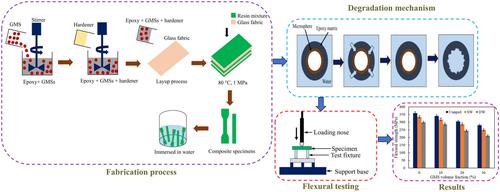当前位置:
X-MOL 学术
›
Polym. Compos.
›
论文详情
Our official English website, www.x-mol.net, welcomes your feedback! (Note: you will need to create a separate account there.)
Mechanical behavior of glass fiber‐reinforced hollow glass particles filled epoxy composites under moisture environment
Polymer Composites ( IF 5.2 ) Pub Date : 2024-03-22 , DOI: 10.1002/pc.28364 Paramasivam Anandakumar 1 , Krishnan Kanny 2 , Turup Pandurangan Mohan 2 , Ramachandran Velmurugan 1
Water absorption increases with the addition of glass microspheres. Microsphere degradation and fiber/matrix debonding are the governing mechanism. Retained 89% of tensile strength of their initial properties after exposed in sea water. Increase in microsphere contents decreases the tensile and flexural strength.
中文翻译:

玻璃纤维增强空心玻璃颗粒填充环氧复合材料在潮湿环境下的力学行为
在海洋应用中使用空心玻璃颗粒填充纤维增强复合材料需要正确了解它们暴露在潮湿环境中时的行为。在这项研究中,制备了体积分数为0%~30%的玻璃微球增强的玻璃纤维增强复合材料,并将其浸入海水和蒸馏水条件下进行单调拉伸和弯曲测试。通过动态机械分析(DMA)、傅里叶变换红外光谱(FT-IR)和扫描电子显微镜(SEM)分析了降解机制。随着玻璃微球的加入,吸湿率结果呈现出增加的趋势。由于吸湿,观察到玻璃化转变温度和储能模量下降。与未老化的样品相比,样品在蒸馏水和海水溶液中的拉伸结果分别降低了 13% 和 9%。与未老化的样品相比,老化的复合材料样品在蒸馏水和海水溶液中的弯曲结果分别减少了 24% 和 11%。研究结果还表明,在两种环境条件下,与湿度对强度的影响相比,湿度对模量的影响不太明显。显微照片结果显示,在潮湿环境中,玻璃微球和纤维/基体界面显着恶化。 吸水率随着玻璃微球的添加而增加。 微球降解和纤维/基体脱粘是控制机制。 暴露在海水中后仍保留其初始性能的 89% 的拉伸强度。 微球含量的增加降低了拉伸强度和弯曲强度。
更新日期:2024-03-22
Polymer Composites ( IF 5.2 ) Pub Date : 2024-03-22 , DOI: 10.1002/pc.28364 Paramasivam Anandakumar 1 , Krishnan Kanny 2 , Turup Pandurangan Mohan 2 , Ramachandran Velmurugan 1
Affiliation

|
中文翻译:

玻璃纤维增强空心玻璃颗粒填充环氧复合材料在潮湿环境下的力学行为



























 京公网安备 11010802027423号
京公网安备 11010802027423号